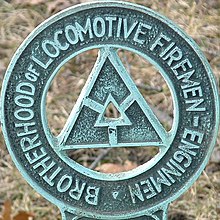Brotherhood of Locomotive Firemen and Enginemen
[1] Although by no means a highly skilled task, locomotive firemen nevertheless needed to develop not only physical prowess, moving heavy coal on a swaying platform, but also a certain job savvy, estimating the engine's burn rate and future fuel needs, making sure that water was continuously in the boiler to avoid an explosion and ensuring that coal was sufficiently and properly spread in the firebox to ensure the locomotive's efficient operation.[6] These men had recently been forced to pass on the news of the fatal accident in a wreck of fellow fireman George Page to his grieving widow the previous month and decided to establish a mutual benefit society for those employed in the locomotive firemen's trade.[7] These met in convention in 1874 and adopted a first constitution for the organization and established a subsidiary institution called the Brotherhood of Locomotive Firemen's Life Insurance Association of the United States.[11] Meetings formally opened with a prayer conducted by the lodge chaplain and were modest and subdued, emphasizing the sacred task of the organization and the need for members to maintain appropriate decorum and professionalism in daily life.[15]Formulaic rituals and organizational secrecy also helped to insure that lodge meetings were orderly, intimate and confidential and contributed to group cohesion among B of LF members.[16] The organization's constitution in 1888 specified that membership requirements included that a candidate be a man "white born, of good moral character, sober and industrious, sound of body and limb".[17] The white-only rule came up for debate in 1896-97, when the B of LF explored membership in the American Federation of Labor, only to learn that the AF of L would require the removal of the offending clause from the group's constitution.[18] The B of LF and other similar railroad brother hoods were, in short, based as much upon a process of exclusion as they were upon unification, as historian Mary Ann Clawson has noted in a 1989 book.The first Grand Secretary and Treasurer was William Sayre of Galion, Ohio, who professed to be a staunch advocate of the theory that personal virtue and good character, economic efficiency and a stable and democratic republic were closely interrelated.In July 1880, a young locomotive fireman turned city clerk from Terre Haute, Indiana named Eugene V. Debs was elected as Grand Secretary and Treasurer of the B of LF.While remaining supportive of the B of LF and its limited mission, over time Debs began to feel the insufficiency of a mere fraternal benefits to solve the fundamental problems facing locomotive firemen and other railway workers, which were often financial in nature and seemed to call for collective action.The 23rd Convention of the Brotherhood of Locomotive Firemen, held in Milwaukee in September 1906, took the step of expanding the scope of the organization and changing its name—an idea that had been discussed for many years previously.Despite great sympathy for the traditional organizational moniker, the convention voted to formally acknowledge the participation of engineers among its membership and changed its name to the Brotherhood of Locomotive Firemen and Enginemen (B of LF&E).







Brotherhood of Locomotive Engineers and TrainmenNorth Americanrailroadfraternal benefit societytrade unionfiremensteam locomotivesrailroad engineerUnited Transportation UnionJoshua A. Leachsteam engineslocomotivesboilersmotive powerlocomotive firemenengineerconductorcaptainsupervisorshard rock minersWestern United Statesamputatedsocial benefitsfraternal organizationsinsuranceBrotherhood of Locomotive Engineerslife insurancePort Jervis, New YorkNew YorkNew JerseyPennsylvaniaIndianasecret societyinitiationFreemasonrychaplainstereopticonEugene V. DebsAmerican Federation of LaborSouthern United StatesFrank W. ArnoldFrank P. SargentNew EnglandRepublicanPresidentTheodore RooseveltGalion, OhioTerre Haute, Indianaembezzlingpromissory noteindustrial unionAmerican Railway Unionstrikesjudicial injunction1894 Pullman strikeMilwaukeeOrder of Railway Conductors and BrakemenBrotherhood of Railroad TrainmenSwitchmen's Union of North AmericaCornell UniversityIthaca, New YorkHornell, NYIndianapolisSt. LouisBuffaloChicagoBostonTerre HauteDenverTorontoPhiladelphiaMinneapolisAtlantaSan FranciscoCincinnatiHarrisburg, PAGalveston, TXDes Moines, IAChattanooga, TNColumbus, OHSt. Paul, MNWashington, D.C.HoustonDetroitList of American railway unionsTunstall v. The Brotherhood of Locomotive Firemen and EnginemenWayback Machine